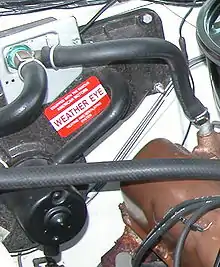Weather Eye
The Weather Eye was a trade name for a Nash Motors-designed fresh-air system for automobile passenger compartment heating, cooling, and ventilating.[1] The Nash "All-Weather Eye" was the first automobile air conditioning system for the mass market.[2] The use of the Weather Eye name for automobile passenger heating and air conditioning systems continued in American Motors Corporation (AMC) vehicles.

The design principles of the Nash Weather Eye system are now in use by nearly every motor vehicle.[3]
Conditioned Air System
In 1938, Nash Motors developed the first automobile heater warmed by hot engine cooling water, and using fresh air.[4] This "Conditioned Air System" is characterized by a cowl-mounted outside air receiver that passes fresh air through a heater core utilizing hot engine coolant for a heat source.[5] The Nash system also pioneered the use of slight pressurization within the passenger compartment to eliminate the infiltration of cold outside air during winter use.[6] This was a fan-boosted filtered ventilation and heating for the passengers, not the modern meaning of an "air conditioning" system.[1] Nash was also the first automobile to make use of a disposable filter in the air-intake to clean incoming air.[3]
The Nash system was a major advancement compared to what was used up to that time: heating by recirculating the air inside the car.[6]
A concurrent development, the Evanair-Conditioner was offered by Hupmobile on their 1938 and 1939 model cars.
Weather Eye
In 1939, Nash added a thermostat to its system, making it the first thermostatic automobile climate control system.[4] The Weather Eye "was the first truly good heating and ventilating system."[7] Additionally, defoggers (defrosters) were incorporated with the introduction of the 3900 series cars that year.[6] The Nash HVAC system was designed by Nils Eric Wahlberg and it continues to be the basis for use in modern automobiles.[3] Nash included the first automatic temperature control for the airside of the heating system with the thermostat sensing the temperatures of the incoming outside air, the heater's discharge, and interior of the car; so that a change in any of these three air temperatures resulted in an automatic adjustment to maintain passenger comfort.[8] Nash's Conditioned Air System heater was now marketed as the "Weather Eye" and consumer sales literature explained that the thermostat's "mechanical eye" watched the weather, hence the name.
All-Weather Eye
In 1954, Nash-Kelvinator capitalized on its experience in refrigeration to introduce the automobile industry's first compact and affordable single-unit heating and air conditioning system optional for all Nash Ambassador, Statesman, and Rambler models.[9][10] It was a true vapor-compression refrigeration system with a compact under the hood and cowl area installation.[2] Combining heating, cooling, and ventilating, the new air conditioning system for the Nash cars was called the "All-Weather Eye".[11]
The 1954 Nash models were the first American automobiles to have a front-end, fully integrated heating, ventilating, and air-conditioning system.[12][13] This was the first mass market system with controls on the dash and an electrically engaged clutch.[14] This "first true refrigerated air conditioner system" for automobiles was also compact and easily serviceable with all of its components installed under the hood or in the cowl area.[1] With a single thermostatic control, the Nash passenger compartment air cooling option was described as "a good and remarkably inexpensive" system.[15]
Entirely incorporated within the engine bay, the combined heating and cooling system had cold air for passengers enter through dash-mounted vents.[10] Nash's exclusive "remarkable advance" was not only the "sophisticated" unified system, but also its US$345 price was significantly less than all the other systems.[16] The optional air conditioning system offered by Oldsmobile cost $199 more and it weighed twice as much as the integrated Nash unit that added only 133 pounds (60 kg).[17]
A feature was the "desert only" setting on the A/C thermostat control, a position that typically ran the compressor continually. In humid environments, the evaporator will freeze up from the accumulating condensation if the compressor operates constantly, which will ultimately block airflow.[18] Other temperature settings cycle the compressor to prevent this problem. Freeze up is not a concern in dry environments such as deserts, and this setting provides constantly cooled airflow into the passenger compartment.
American Motors
First as optional equipment and later as a standard feature, the Weather Eye system was continued by AMC after the merger of Nash-Kelvinator Corporation and Hudson Motor Car Company.[19] A smaller version of AMC's famous Weather-Eye heater was included in the Metropolitan. Improved versions of the "Weather-Eye" heater, fresh-air ventilation was standard on every 1967 AMC Ambassador.[20] The following year, all Ambassadors models came with air conditioning as standard equipment, a feature that at that time still cost extra even on Cadillac, Lincoln, and Imperial models, as A/C that was included in a car's base price was only offered by Rolls-Royce and a few other expensive European cars.[21]
References
- Wolfe, Steven J. (2000). "HVAC Time Line". Refrigeration Service Engineers Society Twin Cities Chapter. Archived from the original on 17 July 2012. Retrieved 19 November 2020.
- "A Counterpersons Guide To Climate Controls". Standard Motor Products. Retrieved 19 November 2020.
- VWLarry (19 May 2009). "Nils Wahlberg and Nash - Salute To A Great Engineer And Unsung Automobiles". Retrieved 19 November 2020.
- Redgap, Curtis. "Nash Motors cars, 1916 to 1954". allpar.com. Retrieved 19 November 2020.
- Heppenheimer, Thomas A. (Spring 2005). "Cold Comfort". Invention & Technology Magazine. 20 (4). Archived from the original on 1 January 2010. Retrieved 19 November 2020.
- Bhatti, Mohinder S. (August 1999). "Evolution of Automotive Heating - Riding in Comfort: Part I" (PDF). ASHRAE Journal: 54. Retrieved 19 November 2020.
- Zimmerman, Frederick (2011). The Turnaround Experience: Real World Lessons in Revitalizing Corporations and Organizations. p. 107. ISBN 9780983903543. Retrieved 19 November 2020.
- Bhatti, page 57.
- Gunnell, John, ed. (1987). The Standard Catalog of American Cars 1946–1975. Krause Publications. p. 176. ISBN 9780873410960.
- Binder, Al; the Ward's staff (1 February 2001). "Rearview Mirror". Ward's AutoWorld. Retrieved 3 November 2014.
- "News of the Automotive World - Nash Air Conditioner Combines Heating, Cooling, and Ventilating". Automotive Industries. 110: 86. 1954. Retrieved 3 November 2014.
- "Nash Low Cost Air Conditioner Cools or Heats by Turning Knob". Popular Mechanics. 101 (5): 86. May 1954. Retrieved 19 November 2020.
- Gantz, Carroll (2015). Refrigeration: A History. McFarland. p. 192. ISBN 9780786476879. Retrieved 19 November 2020.
- Daly, Steven (2006). Automotive Air-Conditioning and Climate Control Systems. Elsevier Science & Technology Books. p. 2. ISBN 9780750669559. Retrieved 19 November 2020.
- Stevenson, Heon J. (2008). American Automobile Advertising, 1930–1980: An Illustrated History. McFarland. p. 177. ISBN 9780786436859. Retrieved 19 November 2020.
- Auto Editors of Consumer Guide (29 November 2007). "1953–1955 Nash and Hudson Ramblers". auto.howstuffworks.com. Archived from the original on 12 August 2020. Retrieved 19 November 2020.
- "Airtemp..... Now, That's Cool!". chrysler300country.com. Archived from the original on 4 November 2014. Retrieved 19 November 2020.
- "All Season Air Conditioning". 1973 AMC Technical Service Manual. oldcarmanualproject.com. p. 12B2. Retrieved 19 November 2020.
- "12A Heater - Weather Eye". AMC Technical Service Manual. oldcarmanualproject.com. 1976. p. 659. Retrieved 19 November 2020.
- Auto Editors of Consumer Guide (11 October 2007). "1967 AMC Ambassador". auto.howstuffworks.com. Archived from the original on 22 September 2020. Retrieved 19 November 2020.
- Auto Editors of Consumer Guide (11 October 2007). "1968 AMC Ambassador". auto.howstuffworks.com. Archived from the original on 19 September 2020. Retrieved 19 November 2020.
